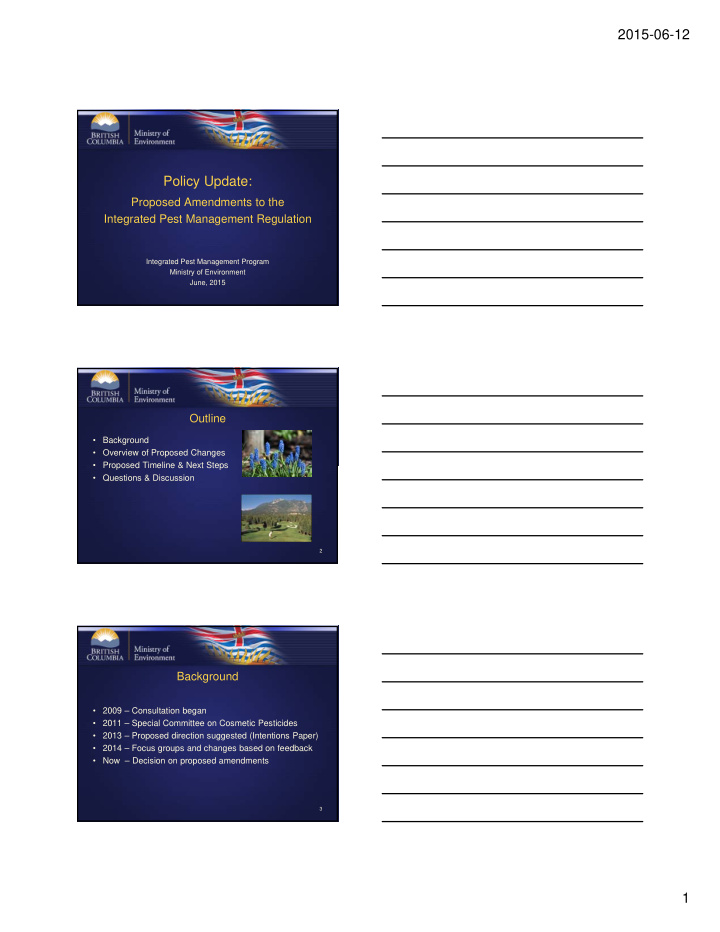



2015-06-12 Policy Update: Proposed Amendments to the Integrated Pest Management Regulation Integrated Pest Management Program Ministry of Environment June, 2015 Outline • Background • Overview of Proposed Changes • Proposed Timeline & Next Steps • Questions & Discussion 2 Background • 2009 – Consultation began • 2011 – Special Committee on Cosmetic Pesticides • 2013 – Proposed direction suggested (Intentions Paper) • 2014 – Focus groups and changes based on feedback • Now – Decision on proposed amendments 3 1
2015-06-12 Objectives of Proposed Amendments Pesticides will be used: • By people with knowledge and training • As part of an Integrated Pest Management (IPM) process Public interaction with pesticide dispensers will increase at the point of sale 4 New Rules for Private Landscapes • Licensing currently required for use on public land and multi-residence properties • Use in private landscapes will now require: – Certification (Residents) – Licensing (Commercial property owners) • Other options: – Hire a licensed company or use an exempted product • Some exemptions apply 5 What is a Landscaped Area? • What: – Lawns, flower beds, ornamental trees and plants, pathways • Where: – Single family homes, golf courses, botanical gardens, cemeteries, commercial property • Does not include: – Food gardens, hobby farms – Structural treatments (e.g., rodents, wasps, carpenter ants) – Forests on private land – Commercial agriculture (e.g. range pasture, field crops) 6 2
2015-06-12 Schedules 2 & 5 • Rules will be different for these products • Schedule 2 – Excluded Pesticides – Already exists – Excluded from most requirements in IPM Regulation – No licence or certificate required for use or sale • Schedule 5 (New) – Provides another option for residents and property managers – Generally considered safe for use by untrained people – No licence or certificate required for use – e.g., Bti, Btk, citric acid, garlic, sodium chloride 7 Exemptions for Glyphosate • Certain exemptions for Domestic Class products only • For treatment of: – Weeds growing through cracks in hard surfaces – Plants poisonous to people by touch – Classified noxious weeds or invasive plants • Residents and property managers will not require a licence or certificate for use on their own property 8 What does it mean to have a licence? • Employing certified pesticide applicators • Environmental protection measures • Implementing an IPM program • Notifying users of the property • Record keeping and reporting • Equipment maintenance and calibration 9 3
2015-06-12 Training – Assistant Applicators • For authorization holders in all sectors • Current - supervise 4 uncertified “assistant applicators” • New - all assistants will be required to: – Receive training – Demonstrate their knowledge in pesticide safety and environmental protection – Be trained and assessed annually • Options: – Ministry-produced online course and exam – In-house training & assessment (must meet Ministry standards) 10 Training for Residents • Residential Applicator Certificate (RAC) • Provides an additional option to expand choices • Allows the use of all Domestic products in landscapes • Free online course and exam • Two hours to complete • Ten year term • Includes information on: – Pesticide safety – Environmental protection – IPM 11 Notifying People About Pesticide Use Residential landscapes: • Service licensees and landlords with RAC • Must notify clients and tenants when use has occurred • Will provide information about: – Pesticides applied – Safety precautions to take – How to obtain more information • Flexible - “door knockers” or written notices 12 4
2015-06-12 Notifying People About Pesticide Use Commercial landscapes: • Includes golf courses, ornamental gardens, cemeteries and commercial facilities (offices & stores) • Landscaped areas the public reasonably may access – Pathways, lawns, picnic areas and golf course fairways • Posting of signs when pesticides are used • Similar to current requirements for posting on public land 13 Role of Vendors • Vendors play a valued role in educating customers • Good support from industry to participate in promoting responsible use of products • Point of sale interaction is very important 14 Licensing for Vendors • Licence required to sell most pesticides • Will include Schedule 5 products • Schedule 2 products do not require a licence to sell • Licensed vendors required to employ certified dispensers 15 5
2015-06-12 Displaying Pesticides • Pesticides will have to be displayed in a manner that restricts customer access – e.g. behind a locked counter or cabinet, empty boxes displayed • Flexibility to respect variation in vendors • Ensures that a certified dispenser communicates with the customer prior to purchase • Anticipated to remove time pressure and disruption at checkout till 16 Interacting with the customer • Current requirements will remain in place: – Inform customer that pesticides can only be used according to the label – Offer advice on pest management and the safe use of pesticides • New requirements: – Confirm intended use is appropriate (according to the label) – Inform customer that: • A provincial licence or certificate may be required • Municipal bylaws may restrict use • Dispensers will not be required to check for certificates or provide details of local bylaws 17 What has changed since 2013? Four key changes since 2013: • Opt-out provision for municipalities and First Nations has been removed • More options for residents: introduction of the Residential Applicator Certificate • Schedule 5 – Products will require a vendor licence to sell – Must be displayed with restricted access – Minor revisions • Vendors will not be required to distribute a handout 18 6
2015-06-12 Time Frame and Next Steps • Regulatory amendment planned for Summer 2015 • Fact sheets and guidance documents for stakeholders will be developed after the regulation is amended • Ministry will engage with manufacturers and distributors on development of vendor material • Intended to come into force: Summer 2016 19 Questions and Discussion 20 Contact Information Christine Woodhouse A/Manager, IPM Program 250-356-5274 Christine.Woodhouse@gov.bc.ca Gwendolyn Lohbrunner Senior IPM Policy Analyst 250-356-9546 Gwendolyn.Lohbrunner@gov.bc.ca 21 7
Recommend
More recommend